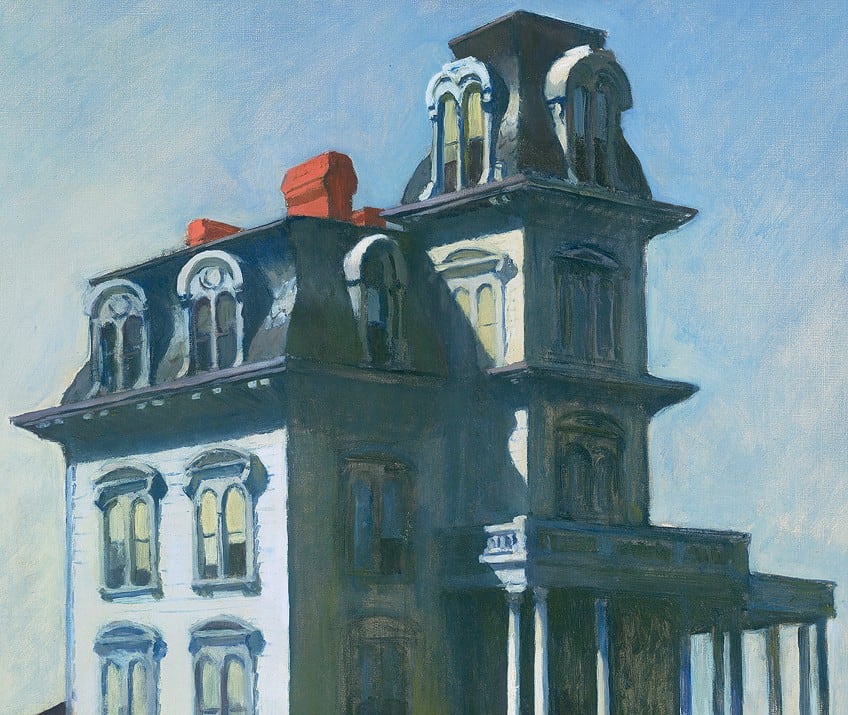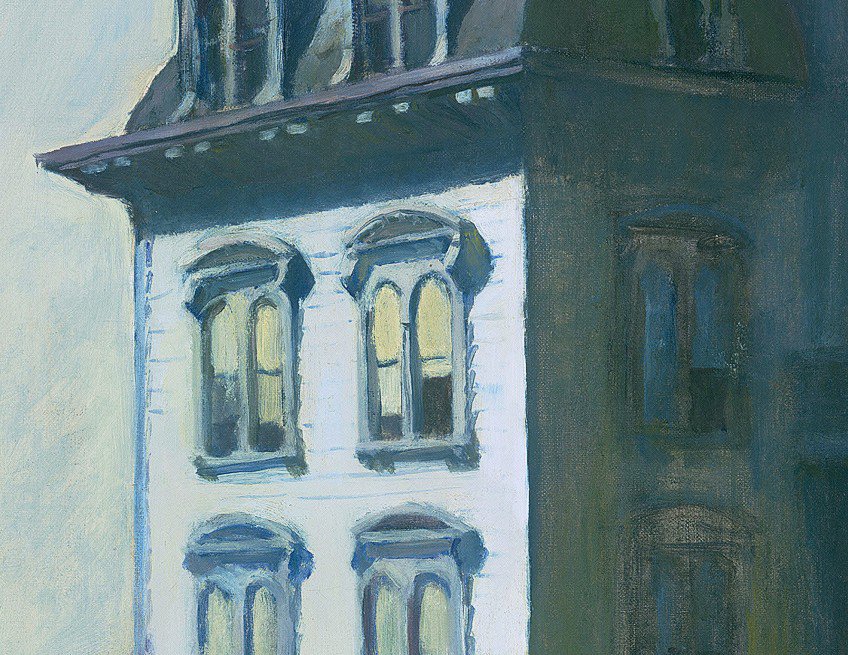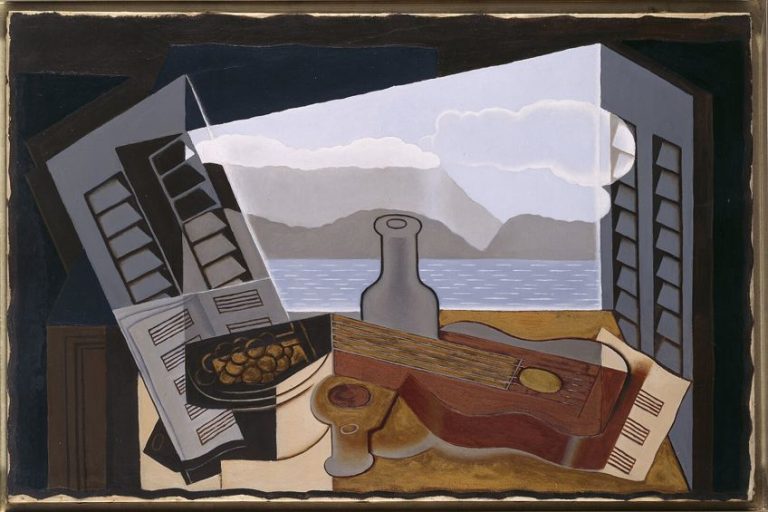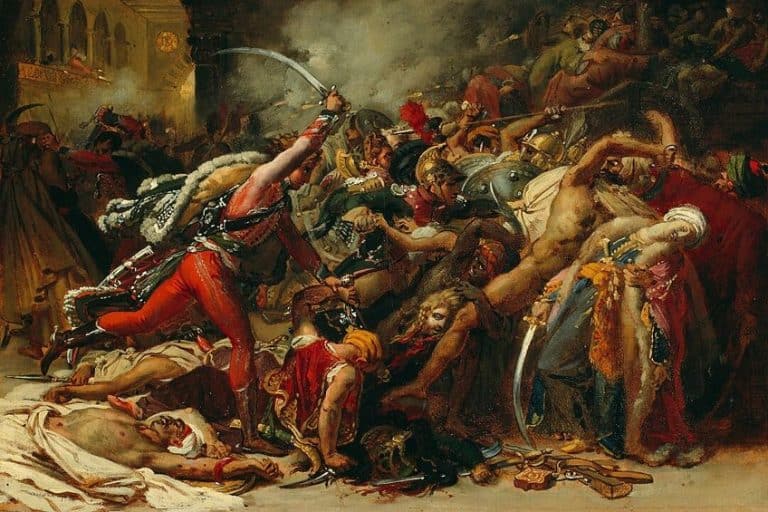“House by the Railroad” by Edward Hopper – A Quick Overview
House by the Railroad (1925) by Edward Hopper is a poignant example that captures primal feelings that almost every human has felt: isolation, loneliness, and the challenges of change. Read more as this article discusses this painting further, how it evokes these deeper feelings of being human, and the effects of progress in society.
Table of Contents
Artist Abstract: Who Was Edward Hopper?
Edward Hopper was born on July 22, 1882, and died on May 15, 1967. He was from Nyack in Rockland County in New York. He was artistic from a young age and some of his studies included the New York School of Art and Design with tutelage from William Merritt Chase.
He was an illustrator in New York and slowly sold his paintings over his artistic career.

He became an inspiring artist for others, from writing to filmmaking and he has always been remembered for his ambient compositions that evoke feelings of mystery and a sense of loneliness. Examples of Hopper’s art include Automat (1927), the famous Nighthawks (1942), and Morning Sun (1952).
House by the Railroad (1925) by Edward Hopper in Context
| Artist | Edward Hopper (1882 – 1967) |
| Date Created | 1925 |
| Medium | Oil on canvas |
| Genre | Landscape/Genre painting |
| Period/Movement | American Realism |
| Dimensions (centimeters) | 61 x 73.7 |
| Series/Versions | N/A |
| Where Is It Housed? | Museum of Modern Art, New York City, United States |
| What It Is Worth | Donated to the Museum of Modern Art in 1930 by Stephen Clark |
In the House by the Railroad analysis, you will learn more about when Edward Hopper painted this oil on canvas and what his inspiration was behind its creation. A formal analysis will also discuss the painting’s subject matter and formal qualities in terms of the main elements of art.
Contextual Analysis: A Brief Socio-Historical Overview
House by the Railroad by Edward Hopper was one of the artist’s characteristic paintings that depicted an everyday scene in modern life, but in this case, it is a house and a railway line, but so much more than that. House by the Railroad painting has often been described in terms of depicting a sense of isolation that modern living brings with it and the railway is a symbol of the progression of industry and how it seemingly leaves the old behind, especially during the 1800s to 1900s in America.
The house in question has also been believed to be inspired by a real house, notably on Route 9W in Haverstraw in Rockland County, New York, United States, and Hopper was reportedly seen near the house when he painted it.
Formal Analysis: A Brief Compositional Overview
In the visual description below, you will read further about the House by the Railroad painting and what subject matter Edward Hopper depicted. You will also read more about how formal qualities like color, brushstrokes, lines, shapes, forms, and space are utilized to create the mood and set the tone of the scene and overall composition.

Subject Matter: Visual Description
House by the Railroad by Edward Hopper depicts a Victorian-style house standing against a light blue sky with whiffs of white clouds. The house itself is a light color and appears to have three stories and an attic. The house stands further into the background of the composition, as the foreground, or lower edge of the painting, depicts the side of a railway line and what appears to be a short embankment on which it is built on. There is no sign or indication of any figures or form of life in the House by the Railroad painting.
It appears to be relegated to the background by the dissecting railway line, which ultimately becomes a symbol of industrial progress and modern living.

Color
There are almost no contrasting colors in House by the Railroad, from light blues, soft yellows, and earthy reds and browns for the railway track. All of which provides a harmony of colors. However, the contrast of light and dark is evident by how Hopper implied the sunlight, which is not visible in the composition but has rendered the house the recipient of casted shadows and light. For example, notice the brighter off-white color on the left side of the house compared to the darker wall to the right, which is in shadow.

Texture
Edward Hopper’s brushstrokes are evident on the canvas itself, which are the tactile textural qualities. There is also implied texture indicated by the different types of brushstrokes, for example, the higgledy-piggledy brushstrokes near the railway’s rim, providing the impression of ground, or the smoother linear brushstrokes on the house to indicate its painted exterior.

Line
There are strong lines in House by the Railroad by Edward Hopper, which are created by the subject matter and other art elements like color that suggest the slivers of light of the sun and cast shadows. For example, notice the horizontal, but diagonal and straight, line implied by the railway line in the foreground, the diagonal line created by the light as it hits the uppermost parts of the house, or the contrast of vertical lines of the house and the horizontal line of the railway as it intersects across the composition.

Shape and Form
House by the Railroad by Edward Hopper consists of a variety of geometric shapes and forms, for example, the square and rectangular shapes of the house, the cylindrical form of the columns, or the organic shapes of the windows’ semi-circular curves.
Additionally, a pattern is formed by the repetition of the square-like sleepers of the railway line.

Space
Hopper skilfully divided the compositional space with the railway line in the foreground, which emphasizes the mood and symbolism of the subject matter. He depicted the sky as a large expanse, further creating a sense of emotional space as the house becomes the only construct there.

A House on the Tracks of Progress
House by the Railroad by Edward Hopper became an inspiration to well-known pop cultural films, for example, it famously inspired the Alfred Hitchcock horror movie Psycho (1960) and the beloved and moody Addams Family’s home, among others. Hopper’s house, left to the burgeoning devices of modernity around it, has become a beacon of what has been left in the tracks of progress: isolation, loneliness, maybe even a sense of sadness.
House by the Railroad by Edward Hopper evokes an ambient quietness, and an empty feeling, and while solitary in its seeming redundancy, it is filled with the certainty of change. The artist has depicted another world of emotion and memory inside an image of what may seem like an average everyday house.
Frequently Asked Questions
Who Painted the Famous Railroad House?
The American Realist painter, Edward Hopper, painted the famous oil on canvas titled House by the Railroad (1925).
Where Is House by the Railroad by Edward Hopper?
House by the Railroad (1925) by Edward Hopper is located at the Museum of Modern Art in New York City, the United States. It was reportedly donated by Stephen Clark around 1930.
What Does House by the Railroad Symbolize?
House by the Railroad (1925) by Edward Hopper has often been believed to be symbolic of the progress in modern life. This has notably focused on the expansion of railway lines and how these have created a sense of isolation for people in society.
Alicia du Plessis is a multidisciplinary writer. She completed her Bachelor of Arts degree, majoring in Art History and Classical Civilization, as well as two Honors, namely, in Art History and Education and Development, at the University of KwaZulu-Natal, South Africa. For her main Honors project in Art History, she explored perceptions of the San Bushmen’s identity and the concept of the “Other”. She has also looked at the use of photography in art and how it has been used to portray people’s lives.
Alicia’s other areas of interest in Art History include the process of writing about Art History and how to analyze paintings. Some of her favorite art movements include Impressionism and German Expressionism. She is yet to complete her Masters in Art History (she would like to do this abroad in Europe) having given it some time to first develop more professional experience with the interest to one day lecture it too.
Alicia has been working for artincontext.com since 2021 as an author and art history expert. She has specialized in painting analysis and is covering most of our painting analysis.
Learn more about Alicia du Plessis and the Art in Context Team.
Cite this Article
Alicia, du Plessis, ““House by the Railroad” by Edward Hopper – A Quick Overview.” Art in Context. December 14, 2023. URL: https://artincontext.org/house-by-the-railroad-by-edward-hopper/
du Plessis, A. (2023, 14 December). “House by the Railroad” by Edward Hopper – A Quick Overview. Art in Context. https://artincontext.org/house-by-the-railroad-by-edward-hopper/
du Plessis, Alicia. ““House by the Railroad” by Edward Hopper – A Quick Overview.” Art in Context, December 14, 2023. https://artincontext.org/house-by-the-railroad-by-edward-hopper/.











